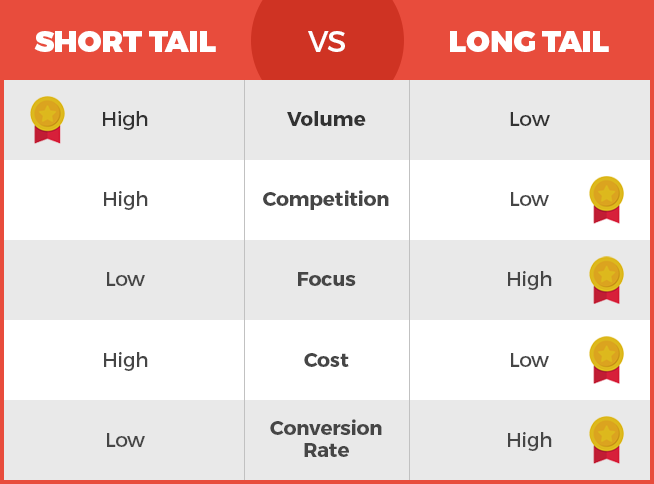In this article, we will talk about the difference between Long Tail vs Short Tail Keywords, how to find them, when and where to use them.
What are Short Tail Keywords?
In search engine optimization (SEO), short-tail keywords are single or two-word phrases that are highly competitive and have a high search volume. For example, “shoes” or “travel” are short-tail keywords.
What Are Long Tail Keywords?
Long-tail keywords are three or more words that are more specific and have a lower search volume. For example, “top rated wedge heels for women” or “cheaper flights to america” are some long-tail keywords.
What is the difference between long tail vs short tail keywords?
There are mainly three differences between short-tail and long-tail keywords is their:
- Search volume
- Competition
- Length
Short-tail keywords are short, common search terms that have a high search volume and high competition. For instance, “shoes” , “car ” or “pizza” are short-tail keywords.
Long-tail keywords are longer, more specific search terms that have a lower search volume and lower competition. For example, “red leather shoes for men” or “gluten-free pizza delivery near me” are long-tail keywords.
In general, long-tail keywords are more easy to rank for than short-tail keywords, because they have a lower competition level.
This means that it is easier to get your website to rank highly for long-tail keywords, and you are more likely to get clicks and conversions from people who search for them.
However, short-tail keywords can still be a valuable part of your SEO strategy. Long-tail keywords can make you reach more audiences and thus get more organic traffic to your website.

image source: https://seopressor.com/blog/short-tail-or-long-tail-keywords
Long Tail vs Short Tail keywords: Which kind of keyword is better?
There is no one-size-fits-all answer to this question, as the best type of keyword for you will depend on your specific goals and objectives.
However, in general, long-tail keywords are considered to be better than short-tail keywords for a number of reasons.
- They are less competitive. There is less competition for long-tail keywords, which means that it is easier to rank for them in search results.
- They attract more targeted traffic. People who search for long-tail keywords are more likely to be interested in what you have to offer, as they are already searching for something specific.
- They convert better. People who search for long-tail keywords are more likely to take action, such as making a purchase or signing up for your email list.
Of course, there are also some advantages to using short-tail keywords. For example, they can help you reach a wider audience.
However, the benefits of long-tail keywords generally outweigh the benefits of short-tail keywords.

Long Tail vs Short Tail keywords: How do you find them?
To find keywords, start by brainstorming words and phrases that people might use when looking for information related to your website or topic.
Put yourself in their shoes and think about what they’d type into a search engine. You can also use tools like:
- Google’s Keyword Planner
- Ubersuggest
- SEMrush
These tools help you discover relevant keywords and provide information about their search volume, competition, and trends.
Below are the steps to find long tail keywords:
Brainstorm:
Think of general topics related to your website or content. This could be anything from the products or services you offer to the industry you’re in.
For example, if you’re a website that sells shoes, you might brainstorm topics like “best running shoes,” “cheap sneakers,” or “comfortable sandals.”
Expand:
Once you have a list of general topics, start to expand on them. This means coming up with variations of the same keyword, as well as synonyms and related terms.
For example, for the topic “best running shoes,” you might come up with variations like “top running shoes,” “fastest running shoes,” or “lightweight running shoes.” You might also come up with synonyms like “athletic shoes” or “trainers.”
Use a keyword research tool:
There are many keyword research tools available online, such as Google Keyword Planner, SEMrush, and Ahrefs.
These tools can help you find short and long-tail keywords that are relevant to your target audience and have a high search volume.
Analyze:
Analyze the keyword deeply and find out the following stats of keyword:
- Search volume: This represents the total time of searches for a specific keyword within a month.
- Competition: This is the number of other websites that are ranking for a particular keyword.
- Other factors: These could include the intent of the user, the relevance of the keyword to your website, and the length of the keyword tail.
By analyzing all of these factors, you can choose the right keywords for your website or content.

Choose:
Select keywords that match your content. Mix short and long ones, balancing search volume and competition.
This strategy ensures your content reaches the right audience effectively.
Use Google’s autocomplete suggestions:
When you type a keyword into Google’s search bar, the search engine will suggest other related keywords. These suggestions can be a great way to find new long-tail keywords that your target audience is using.
Use Google’s “People also ask” box. Google’s “People also ask” box is located below the search results.
It displays a list of questions that people have asked about the topic you’re researching. We can get many good long-tail keywords by Google autocomplete suggestions.
Analyze your competitors’ websites:
Take a look at the keywords that your competitors are ranking for.
These keywords will provide you with suggestions for long-tail keywords to focus on. The use of tools such as SEMrush or Ahrefs can help you identify the keywords that your competitors are gaining rankings for.
Use social media:
Pay attention to the keywords that people are using on social media when they discuss your industry or topic.
These keywords can be a great source of short and long-tail keywords. You can use a tool like BuzzSumo or Keyhole to see which keywords are being used on social media.
Use your own website traffic data:
If you have a website, you can use your own traffic data to find out which keywords are driving traffic to your site.
This information can help you identify short and long-tail keywords that are relevant to your target audience.
Use a combination of methods:
The best way to find short and long-tail keywords is to use a combination of methods.
This will help you to find a wider range of keywords that are relevant to your target audience.
Long Tail vs Short Tail Keywords: Distribution in Content
The distribution of long tail keywords and short tail keywords in content depends on your specific SEO strategy and the goals of your content.
Here’s a breakdown of how you might use each type of keyword:
Short Tail Keywords:
Usage: Short tail keywords are typically shorter and more general terms, often one to three words long. They have higher search volume but also higher competition.
Distribution: It’s usually a good practice to use short tail keywords sparingly in your content. Place them strategically in the title, headers, and naturally throughout the content. Make sure they fit naturally in your article.
Long Tail Keywords:
Usage: Long tail keywords are like longer, detailed phrases made up of several words. Not many people search for them, but not many websites compete for them either.
Distribution: Long tail keywords should be incorporated more liberally into your content, especially in blog posts, articles, or product descriptions. They often make for more natural and informative content because they are specific to a particular topic or query. Use them in titles, subtitles, and throughout the text where they fit naturally.
Balancing Both:
Usage: To create a balanced content strategy, consider using a mix of both short tail and long tail keywords.
Distribution: Use short tail keywords strategically to capture a broad audience, and complement them with long tail keywords to target niche or specific audience segments. This strategy helps you cover both high-competition and low-competition keyword areas.
User Intent:
Usage: Always keep user intent in mind. Think about what your target audience is searching for and what information or solutions they seek.
Distribution: Align your content with the intent behind the keywords. Short tail keywords may reflect informational or navigational intent, while long tail keywords often indicate transactional or specific informational intent.

When to use long-tail keywords?
Long-tail keywords are more specific and a bit longer phrases that users use while searching online. They are different from short keywords, which are shorter and more general.
You should use long-tail keywords when you want to target a specific audience or topic.
For example, if you have a website about gardening, a short keyword might be “plants,” but a long-tail keyword could be “best indoor plants for low light.”
Here are some situations where using long-tail keywords can be helpful:
Less Competition:
Long-tail keywords usually have less competition compared to short ones.
This means it’s easier for your website to show up in search results when people look for those specific phrases.
Targeted Audience:
If you want to attract a particular group of people interested in something specific, using long-tail keywords can help.
This ensures that the people who find your website are more likely to be interested in what you offer.
Higher Conversion:
People searching with long-tail keywords often have a clearer idea of what they’re looking for.
So, if your website matches their specific search, they’re more likely to stay and explore, increasing the chances of them converting into customers or readers.

Voice Search and Natural Language:
With the rise of voice assistants like Siri and Google Assistant, people are using more natural language when searching.
Long-tail keywords mimic these conversational phrases and can make your content more discoverable.
Niche Topics:
If your website is about something very specific, short keywords might not cover all aspects.
Long-tail keywords allow you to delve into niche topics and attract visitors looking for detailed information.
Blog Posts and Content Creation:
When writing blog posts or creating content, long-tail keywords provide you with specific topics to focus on.
This can help you create more in-depth and valuable content for your audience.
Remember, using long-tail keywords does not mean you should ignore short keywords entirely. They both have their place in an effective SEO strategy.
It’s about finding the right balance and using the keywords that match your content and your target audience’s search intent.

When to use short-tail keywords?
Short-tail keywords are concise search terms composed of one or two words, such as “shoes” or “weather.”
They are typically used in scenarios where you want to cast a wide net to attract a large audience.
Here’s a detailed explanation using simple language:
Broad Search:
Short-tail keywords are used when you want to reach a broad range of people who may be searching for various aspects related to the keyword.
For instance, using “travel” as a keyword could capture people interested in travel destinations, tips, deals, and more.
Brand Awareness:
If you’re trying to increase brand visibility, short-tail keywords can help.
By targeting simple and popular terms related to your brand or industry, you can make your brand more recognizable.
High Volume:
Short-tail keywords usually have higher search volumes because they are general terms that many people search for.
So, when you want to generate a lot of search traffic, these keywords can be effective.
Competitive Niches:
In competitive industries, ranking for long-tail keywords might be challenging due to intense competition.
Short-tail keywords can be a way to gain some traction and visibility despite the competition.
Paid Advertising:
Short-tail keywords are often used in pay-per-click (PPC) advertising campaigns.
They can attract a larger audience and may lead to more clicks, even though the conversion rate might be lower compared to more specific keywords.
However, there are some things to consider:
Lower Relevance: Short-tail keywords can be less relevant to specific queries. Someone searching for “shoes” might be looking for different types, colors, or sizes of shoes, making it challenging to cater to their exact needs.
Higher Bounce Rate: Due to their generality, short-tail keywords might attract visitors who don’t find exactly what they’re looking for on your website, leading to a higher bounce rate.
Budget: In paid advertising, short-tail keywords can be more expensive due to their popularity. This might strain your budget quickly, especially if clicks don’t convert into meaningful actions.
Short-tail keywords are suitable when you want to reach a large audience, increase brand visibility, or operate in competitive niches.
They are beneficial for driving high search volume and can be effective in paid advertising. However, keep in mind that they might have lower relevance and could result in higher bounce rate.
Which type of keywords should you use?
The best type of keywords for you will depend on your specific goals.
If you want to reach a large audience and generate a lot of traffic, then short-tail keywords are a good option.
However, if you want to target a specific audience and generate more conversions, then long-tail keywords are a better choice.
In general, it is a good idea to use a combination of both short-tail and long-tail keywords in your SEO strategy. This will help you reach a wider audience and generate more conversions.
Points to find better keywords:
Following are the few important points to find better keywords to get ranked in search engines in short time.
Focus on long-tail keywords
Long-tail keywords have lower search volumes than short-tail keywords, but they also have less competition.
It means that it is far easier to rank for long-tail keywords then short-tail keywords.
Use a variety of keyword tools
Different keyword tools have different strengths and weaknesses. Do experiment with some known tools to find about the one that works best for you.
Analyze your target audience.
What are your target customers searching for?
What are their pain points? The more you know about your target audience, the better you will be able to find the right keywords to target.

Consider the intent of the searcher.
When someone searches for a long-tail keyword, they are usually looking for something specific.
When a person searches for a short-tail keyword, they may be looking for something more general.
Keep up with trends.
Keyword trends change over time. Make sure to keep up with the latest trends so that you can target the most relevant keywords.
Remember, the goal is to find keywords that accurately represent what your content offers and that people are likely to search for.
This can help improve your website’s visibility in search engines and bring in more relevant visitors.
Warp Up:
To sum it up, when it comes to choosing between long tail and short tail keywords, it really depends on how much and how quickly you want to see results.
Short tail keywords are short in length and general, making them great for reaching a large amount of audience. However, they face tough competition.
Long tail keywords are longer and more specific, better for targeting a particular audience.
They might not bring as much traffic on their own, but they’re easier to rank for and can attract motivated visitors, especially if you’re in a niche market.
The best strategy often involves using a mix of both short and long tail keywords.
Short ones can get you noticed, and long ones can help you connect with people who are ready to buy.
Frequently Asked Questions about long tail vs short tail keywords.
Are long tail keywords better?
Yes, long-tail keywords are generally better than short-tail keywords.
They are less competitive, attract more targeted traffic, and convert better. However, there are some cases where short-tail keywords can be a better choice.
For example, if you are trying to reach a large audience or if you are just starting out and don’t have a lot of authority in your niche, short-tail keywords can be a good way to get your foot in the door.
What are short tail and long tail keywords used for?
Short-tail keywords are used to target a broad audience, while long-tail keywords are used to target a more specific audience.
Short-tail keywords are often used for branding and awareness campaigns, while long-tail keywords are often used for lead generation and conversion campaigns.
What is an example of a long-tail keyword?
An example of a long-tail keyword is “best red leather shoes for men“.
This keyword is more specific than the short-tail keyword “shoes“, and it is more likely to be used by people who are actually interested in buying red leather shoes for men.
What are some short-tail keywords generator tools?
Some short-tail keywords generator tools include:
- Google Keyword Planner
- Ubersuggest
- Ahrefs Keyword Explorer
- SEMrush Keyword Magic Tool
- Keyword Sheeter
What are some long-tail keywords generator tools?
Some long-tail keywords generator tools include:
- Answer the Public
- Soovle
- Long Tail Pro
- Phrase Hunter
More on keyword research:
Why Keyword Research Is Important in SEO?
25 Amazon Keyword Research Tools To Boost Your Sales
Free Fiverr Keyword Research Tool and Methods
Keywords For Craigslist Search: Find and Use
4 Reasons To Focus On Low-Volume Keywords In Your SEO
How to Choose the Right Keywords for SEO?
Find Low-Competition Keywords With High Traffic: Secret Revealed

